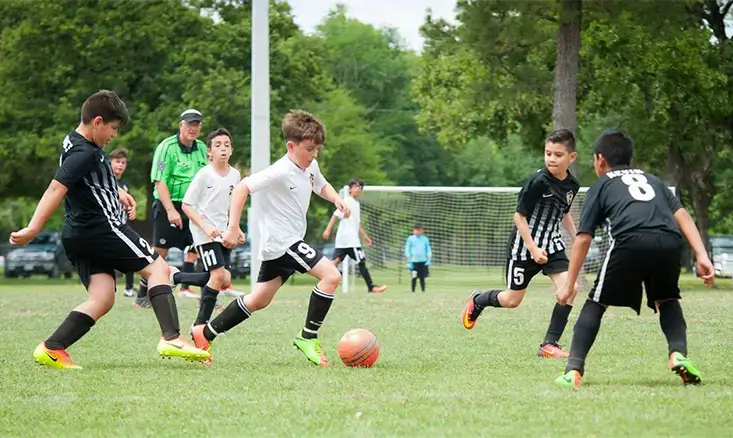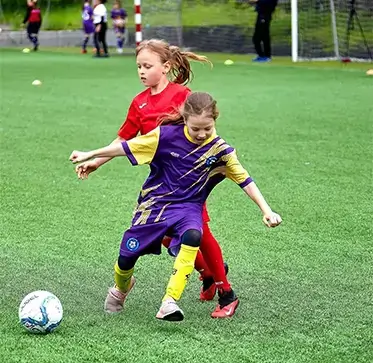CRFC BLOGS
LATEST BLOGS & NEWSLETTERS
The Ultimate Guide to 7v7 Soccer Rules for Youth Players
Soccer’s 7v7 formation is a perfect way to introduce young players to the game. This smaller, fast-paced format helps young players develop critical skills, build teamwork, and enjoy the sport. For parents, coaches, and players alike, understanding the rules for 7v7 soccer is crucial to maximizing the fun and learning experience.
What is 7v7 Soccer?
Key Features of 7v7 Soccer
-
Team Size
Seven players per side, including a goalkeeper.
-
Smaller Fields
Tailored to the abilities of younger players.
-
Faster Pace
Encourages quick decision-making and skillful play.

How to Play 7v7 Soccer
1. Team Setup
- Each team has 7 players on the field: 6 outfield players and 1 goalkeeper.
- Teams must have at least 4 players to start the match.
- Unlimited substitutions are allowed, encouraging participation and reducing fatigue.
2. Field Dimensions and Equipment
-
Field Size
7v7 soccer is played on smaller fields to suit young players. The dimensions are typically half the size of a standard soccer field, making it manageable for youth soccer players.
-
Goals
Goals are smaller to reflect the game’s scale and challenge players to improve accuracy.
-
Ball
A size-4 soccer ball is commonly used for youth matches, as it is lighter and more accessible for young players to control.

3. Game Duration
-
Game Length
Two halves of 20–25 minutes each.
-
Break
A halftime break of 5–10 minutes.
This structure ensures that the game remains engaging while preventing fatigue.
4. Key Rules of Play
The rules for 7v7 soccer are designed to keep the game safe, fair, and enjoyable for all players.-
Kick-Off:
- At the start of the game and after every goal, a kick-off is taken from the center.
- The ball can move in any direction.
- Opposing players must stand at least 5 yards away from the ball.
-
No Heading:
- In leagues like U10 7v7 soccer, deliberate ball heading is prohibited to protect young players from injury.
- If a player heads the ball intentionally, the opposing team is awarded an indirect free kick.
-
Offside Rules:
- The offside rule is often simplified or not enforced in younger leagues, allowing for more accessible gameplay.
-
Fouls and Free Kicks:
- Fouls such as tripping, pushing, or handball result in a free kick for the opposing team.
- Free kicks can be:
- Direct: A player can shoot directly at the goal.
- Indirect: Another player must touch the ball before a shot is taken.
-
Goalkeeper Rules:
- Goalkeepers can use their hands within the penalty area.
- The opposing team is awarded a free kick if the goalkeeper steps outside the area and handles the ball.

Strategies for Success in Youth 7v7 Soccer
Playing 7v7 soccer effectively requires a mix of individual skill and team coordination. Here are some tips for young players and their coaches:
1. Stay Spread Out
With fewer players on the field, avoiding crowding around the ball is important. Staying spaced out creates more passing options and keeps the game flowing.
2. Quick Passing
The smaller field size rewards short, accurate passes over long ones. Players should practice moving the ball quickly to maintain possession.
3. Communicate as a Team
Talking to teammates is crucial in 7v7 soccer. Players should call for the ball, organize the defense, and coordinate attacks.
4. Rotate Positions
Encourage players to try different positions, including goalkeeper, defender, and forward. This helps them understand the game better and builds versatility.
Tournaments and Indoor Variations
1. Tournaments
-
Rules
Matches may include tie-breakers, penalty shootouts, or golden goals to decide winners.
-
Format
It often features group stages followed by knockout rounds.
2. Indoor Soccer
7v7 indoor soccer rules are similar to outdoor regulations but with a few changes:- The ball is kept in play by walls or barriers.
- Games are faster-paced, requiring quick reflexes and decision-making.

Benefits of 7v7 Soccer for Youth Players
- Skill Development Players get more touches on the ball, improving their dribbling, shooting, and passing skills.
- Teamwork and Communication Smaller teams require players to work together and talk constantly, developing collaboration.
- Confidence Building With fewer players, each child has a chance to make meaningful contributions, boosting self-esteem.
- Physical Fitness Soccer promotes cardiovascular health, agility, and endurance, helping young players stay active and healthy.
- Fun and Enjoyment The fast-paced nature of 7v7 soccer keeps the game exciting for everyone involved.
Conclusion
Youth soccer is about more than just winning—it’s about learning, growing, and having fun. 7v7 soccer strikes the perfect balance between competition and development, offering young players a chance to build their skills in a supportive environment.
FAQs
What is 7v7 soccer?
7v7 soccer is a smaller version of regular soccer, played with seven players per team on a smaller field. It’s designed to help young players develop skills and enjoy faster-paced games.
What are the key rules of 7v7 soccer?
Each team has 6 outfield players and a goalkeeper, with unlimited substitutions. For younger leagues, there’s no heading, and the offside rule may be simplified or skipped.
What are the field and ball sizes for 7v7 soccer?
The field is about half the size of a standard soccer field, with smaller goals. A size-4 ball is typically used for younger players, making it easier to control.
How long is a 7v7 soccer game?
Games usually consist of two halves, each 20–25 minutes long, with a short halftime break. This keeps the game fun and prevents fatigue.
Why is 7v7 soccer great for kids?
It offers more touches on the ball, encourages teamwork, and helps build confidence. The smaller format ensures every player gets involved and grows their skills!

Did you find this useful?


